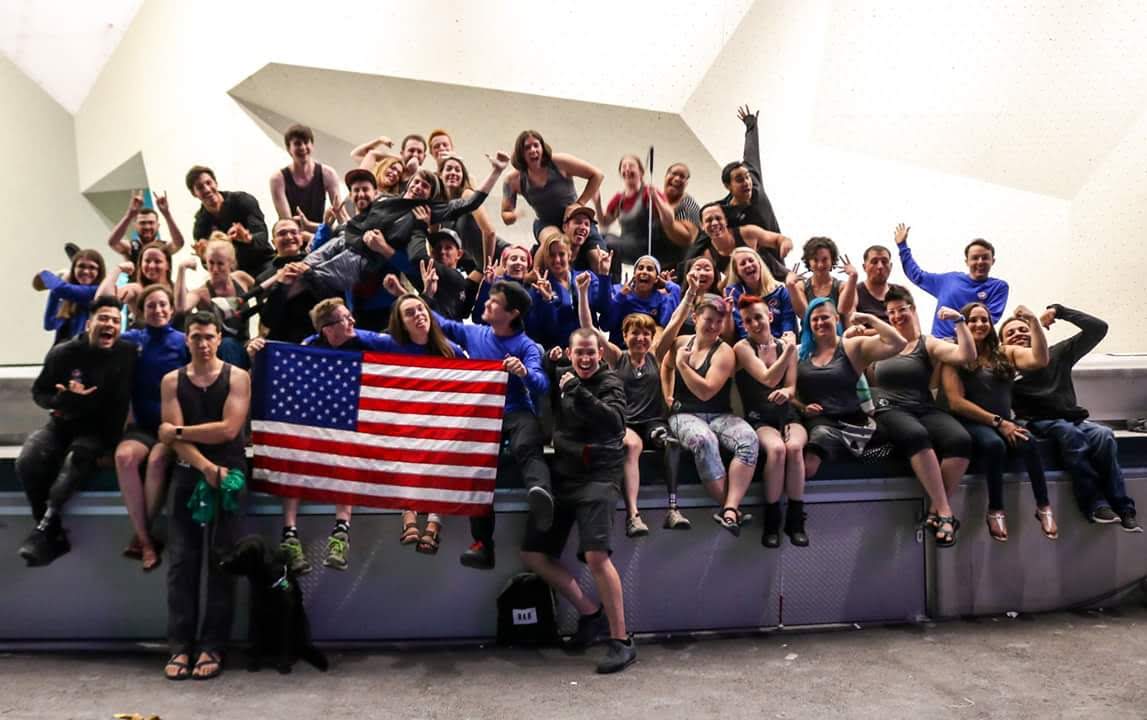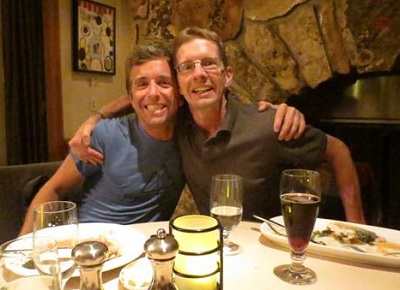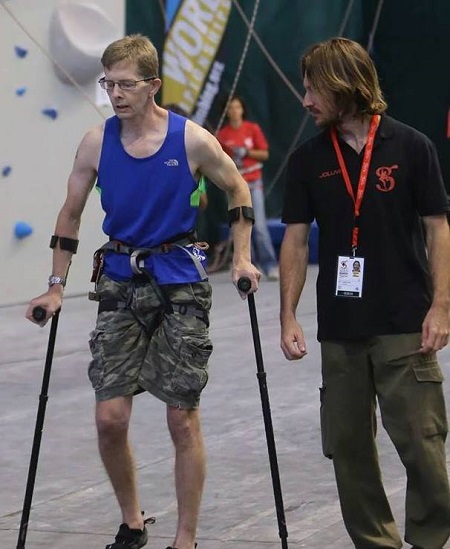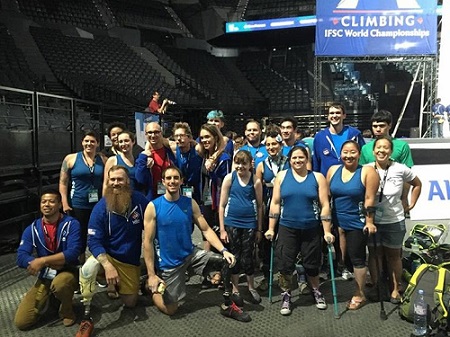Here Since (Almost) the Beginning

By Adam Payne
 Hello from the concrete jungle of New York City, my name is Adam. In the fall of 2013 I went to the Gunks with the Adaptive Climbing Group (my home climbing group here in New York). Our van for the weekend was driven by Timmy O’Neill, whom I had never heard of. He seemed like a nice guy so we bonded over Led Zeppelin in the van, and he introduced me to Paradox Sports. Now that I know him better, I like to think that he saw something in my nascent climbing ability. That and our shared desire to belt out Led Zepplin tunes.
Hello from the concrete jungle of New York City, my name is Adam. In the fall of 2013 I went to the Gunks with the Adaptive Climbing Group (my home climbing group here in New York). Our van for the weekend was driven by Timmy O’Neill, whom I had never heard of. He seemed like a nice guy so we bonded over Led Zeppelin in the van, and he introduced me to Paradox Sports. Now that I know him better, I like to think that he saw something in my nascent climbing ability. That and our shared desire to belt out Led Zepplin tunes.
I have Ataxia. Ataxia is a rare, not very well understood, progressive, neuromuscular disease. Essentially Ataxia is a description for a group of symptoms that make sure that commands from my brain don’t always travel in a timely fashion to where they are expected. This can be life threatening – like when a homicidal NYC cabbie is bearing down on me or funny like when I try to balance. It’s unpredictable.
 But saying that is to focus too much on my disability. To paraphrase the words of Malcolm Daly (co-founder of Paradox Sports), “We don’t care what you can’t do but what you can”. What I can do is climb. I may not be the best climber, but I am persistent and I do have fun. That’s why I go to Paradox Sports events. I get to work on the sport I love and I get to hang out with some of the best people I have ever met. Climbing has brought me all over the country and the world. Wherever I go I’m likely to run into at least one, and probably a few Paradox Sports people.
But saying that is to focus too much on my disability. To paraphrase the words of Malcolm Daly (co-founder of Paradox Sports), “We don’t care what you can’t do but what you can”. What I can do is climb. I may not be the best climber, but I am persistent and I do have fun. That’s why I go to Paradox Sports events. I get to work on the sport I love and I get to hang out with some of the best people I have ever met. Climbing has brought me all over the country and the world. Wherever I go I’m likely to run into at least one, and probably a few Paradox Sports people.
The best part of being involved with Paradox Sports for as long as I have, is that I have been part of the beginnings of competitive paraclimbing in America. Competitive “adaptive” climbing began in America (without me) in 2012, at City Rock in Colorado Springs, Colorado. The next year I went to Vail Colorado for the 2013 GoPro Mountain Games. They had an adaptive bouldering category which they called a citizen’s comp. The citizens included representatives from the big three adaptive groups in the country; the Adaptive Climbing Group (Brooklyn Boulders, NY), Catalyst Sports (Stone Summit, GA) and Paradox Sports (Colorado and the west).
Although I looked good, I lost. In the words of a fellow competitor I was very depressed for like a minute… then I was hooked. The next competition was a bouldering comp in Colorado again at City Rock, I took second in my classification.
From the very beginning competitions were run using the International Federation of Sport Climbers (IFSC) classification system. There were upper extremity amputees, lower extremity amputees, blind (visually impaired), seated climbers (people in wheelchairs with no use of their legs) and finally neurological and physical disabilities (my category, now called “range of power”). This was important for our international classification, but in the beginning mainly meant that I wouldn’t be competing against Maureen Beck or Ronnie Dickson. This was good mainly because they were and still are better climbers than me.
 I won third at the first annual adaptive route climbing competition at Stone Summit in Atlanta, GA. This qualified me to go to the world championships in Spain. World’s was incredible. By 2014 I had only been climbing 2 years. I was 43 years old and yet I was in Spain, at a world class climbing venue with many of my climbing idols (awards were given by Adam Ondra and Kim Jain). Also, when I got there they gave us all a laminated ID card that said we were ATHLETES. While the thought that I was an athlete and that I was hanging around with these athletes sunk in; I watched some great climbing, learned the wonders of the isolation area, drank a lot of really good wine and had a near death experience trying a sport climb. Then I went home.
I won third at the first annual adaptive route climbing competition at Stone Summit in Atlanta, GA. This qualified me to go to the world championships in Spain. World’s was incredible. By 2014 I had only been climbing 2 years. I was 43 years old and yet I was in Spain, at a world class climbing venue with many of my climbing idols (awards were given by Adam Ondra and Kim Jain). Also, when I got there they gave us all a laminated ID card that said we were ATHLETES. While the thought that I was an athlete and that I was hanging around with these athletes sunk in; I watched some great climbing, learned the wonders of the isolation area, drank a lot of really good wine and had a near death experience trying a sport climb. Then I went home.
Before Spain I had known that what I was doing was athletic, but it was just a fun hobby which, in my mind, was not something an athlete would do. Now I had proof that an athlete would do this and that I was that athlete. It made me feel that what I was doing was not only a lot of fun for me but important to people other than me.
Back in the US paraclimbing was advancing as a sport. Although our contests still didn’t have much of a crowd we did have competitors. When we started in 2012 we fielded less than ten athletes, in 2013 we had less than twenty, in 2014 we had maybe thirty. From there we took off: 40… 80… In 2020, before the intervention of the coronavirus, shelter in place orders and the postponement of all sporting events, we were expecting a hundred or more. The event will be rescheduled and will consist of two days, qualifications and finals for all categories.
Competitive adaptive climbing in the US has only been around for eight years but in that time the competition has become better and better. At the first Nationals in Georgia we had 4 neurological competitors. Of the three medalists, we managed to win either gold, silver or bronze for the next three years.
That record still stands and it still is an accomplishment to be proud of but it is not something that would happen today. As adaptive climbing has gotten bigger over the years the level of competition has increased. Pro-climbers complain (good-naturedly) that the new crop of climbers can warm up on their projects. For years adaptive climbing has been different. The very nature of adaptive climbing says that we are dealing with our own, often significant issues but it doesn’t mean that we can’t be excellent climbers too. People seem to be beginning to realize that.


 Hello from the concrete jungle of New York City, my name is Adam. In the fall of 2013 I went to the Gunks with the Adaptive Climbing Group (my home climbing group here in New York). Our van for the weekend was driven by Timmy O’Neill, whom I had never heard of. He seemed like a nice guy so we bonded over Led Zeppelin in the van, and he introduced me to Paradox Sports. Now that I know him better, I like to think that he saw something in my nascent climbing ability. That and our shared desire to belt out Led Zepplin tunes.
Hello from the concrete jungle of New York City, my name is Adam. In the fall of 2013 I went to the Gunks with the Adaptive Climbing Group (my home climbing group here in New York). Our van for the weekend was driven by Timmy O’Neill, whom I had never heard of. He seemed like a nice guy so we bonded over Led Zeppelin in the van, and he introduced me to Paradox Sports. Now that I know him better, I like to think that he saw something in my nascent climbing ability. That and our shared desire to belt out Led Zepplin tunes. But saying that is to focus too much on my disability. To paraphrase the words of Malcolm Daly (co-founder of Paradox Sports), “We don’t care what you can’t do but what you can”. What I can do is climb. I may not be the best climber, but I am persistent and I do have fun. That’s why I go to Paradox Sports events. I get to work on the sport I love and I get to hang out with some of the best people I have ever met. Climbing has brought me all over the country and the world. Wherever I go I’m likely to run into at least one, and probably a few Paradox Sports people.
But saying that is to focus too much on my disability. To paraphrase the words of Malcolm Daly (co-founder of Paradox Sports), “We don’t care what you can’t do but what you can”. What I can do is climb. I may not be the best climber, but I am persistent and I do have fun. That’s why I go to Paradox Sports events. I get to work on the sport I love and I get to hang out with some of the best people I have ever met. Climbing has brought me all over the country and the world. Wherever I go I’m likely to run into at least one, and probably a few Paradox Sports people. I won third at the first annual adaptive route climbing competition at Stone Summit in Atlanta, GA. This qualified me to go to the world championships in Spain. World’s was incredible. By 2014 I had only been climbing 2 years. I was 43 years old and yet I was in Spain, at a world class climbing venue with many of my climbing idols (awards were given by Adam Ondra and Kim Jain). Also, when I got there they gave us all a laminated ID card that said we were ATHLETES. While the thought that I was an athlete and that I was hanging around with these athletes sunk in; I watched some great climbing, learned the wonders of the isolation area, drank a lot of really good wine and had a near death experience trying a sport climb. Then I went home.
I won third at the first annual adaptive route climbing competition at Stone Summit in Atlanta, GA. This qualified me to go to the world championships in Spain. World’s was incredible. By 2014 I had only been climbing 2 years. I was 43 years old and yet I was in Spain, at a world class climbing venue with many of my climbing idols (awards were given by Adam Ondra and Kim Jain). Also, when I got there they gave us all a laminated ID card that said we were ATHLETES. While the thought that I was an athlete and that I was hanging around with these athletes sunk in; I watched some great climbing, learned the wonders of the isolation area, drank a lot of really good wine and had a near death experience trying a sport climb. Then I went home.